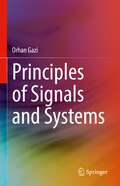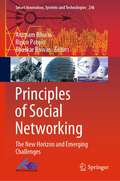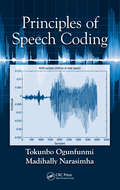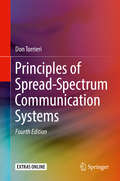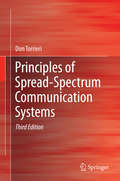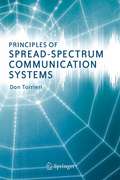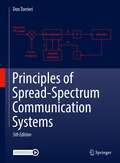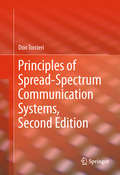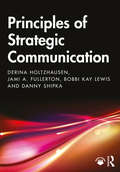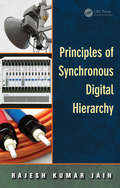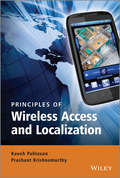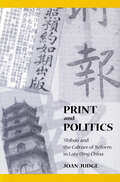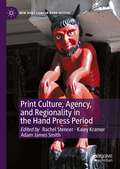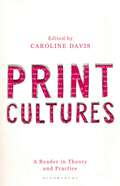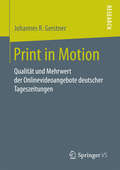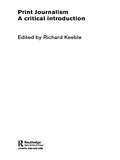- Table View
- List View
Principles of Signals and Systems
by Orhan GaziThe textbook presents basic concepts of signals and systems in a clear manner, based on the author’s 15+ years of teaching the undergraduate course for engineering students. To attain full benefit from the content, readers should have a strong knowledge of calculus and be familiar with integration, differentiation, and summation operations. The book starts with an introduction to signals and systems and continues with coverage of basic signal functions and their manipulations; energy, power, convolution, and systems; Fourier analysis of continuous time signals and digital signals; Laplace transform; and Z transforms. Practical applications are included throughout. The book is also packed with solved examples, self-study exercises, and end of chapter problems.
Principles of Social Networking: The New Horizon and Emerging Challenges (Smart Innovation, Systems and Technologies #246)
by Anupam Biswas Ripon Patgiri Bhaskar BiswasThis book presents new and innovative current discoveries in social networking which contribute enough knowledge to the research community. The book includes chapters presenting research advances in social network analysis and issues emerged with diverse social media data. The book also presents applications of the theoretical algorithms and network models to analyze real-world large-scale social networks and the data emanating from them as well as characterize the topology and behavior of these networks. Furthermore, the book covers extremely debated topics, surveys, future trends, issues, and challenges.
Principles of Speech Coding
by Tokunbo OgunfunmiIt is becoming increasingly apparent that all forms of communication-including voice-will be transmitted through packet-switched networks based on the Internet Protocol (IP). Therefore, the design of modern devices that rely on speech interfaces, such as cell phones and PDAs, requires a complete and up-to-date understanding of the basics of speech
Principles of Spread-Spectrum Communication Systems
by Don TorrieriThis thoroughly revised textbook provides the fundamentals of spread-spectrum systems with a continued emphasis on theoretical principles. The revision includes new sections and appendices on characteristic functions and LaPlace transforms, orthonormal expansions of functions, the SNR wall in detection, multiple-input multiple-output systems, multicode and multirate systems, interference cancelers, complementary codes, chaos and ultrawideband systems, and the normalized LMS algorithm. As with previous editions, the author presents topics in a practical way that is of interest to both researchers and system designers. He includes updated problems at the end of each chapter, which are intended to assist readers in consolidating their knowledge and to provide practice in analytical techniques. In addition to the new and revised material, the author adds 50 new pages to make the book more accessible to graduate students in electrical engineering.
Principles of Spread-Spectrum Communication Systems
by Don TorrieriThis textbook provides a concise but lucid explanation of the fundamentals of spread-spectrum systems with an emphasis on theoretical principles. The choice of specific topics is tempered by the author’s judgment of their practical significance and interest to both researchers and system designers. Throughout the book, learning is facilitated by many new or streamlined derivations of the classical theory. Problems at the end of each chapter are intended to assist readers in consolidating their knowledge and to provide practice in analytical techniques. This third edition includes new coverage of topics such as CDMA networks, Acquisition and Synchronization in DS-CDMA Cellular Networks, Hopsets for FH-CDMA Ad Hoc Networks, and Implications of Information Theory, as well as updated and revised material on Central Limit Theorem, Power Spectral Density of FH/CPM Complex Envelopes, and Anticipative Adaptive-Array Algorithm for Frequency-Hopping Systems.
Principles of Spread-Spectrum Communication Systems
by Don TorrieriOriginally adopted in military networks as a means of ensuring secure communication when confronted with the threats of jamming and interception, spread-spectrum systems are now the core of commercial applications such as mobile cellular and satellite communication. This book provides a concise but lucid explanation and derivation of the fundamentals of spread-spectrum communication systems. The level of presentation is suitable for graduate students with a prior graduate-level course in digital communication and for practicing engineers with a solid background in the theory of digital communication. As the title indicates, the author focuses on principles rather than specific current or planned systems. Although the exposition emphasizes theoretical principles, the choice of specific topics is tempered by their practical significance and interest to both researchers and system designers. Throughout the book, learning is facilitated by many new or streamlined derivations of the classical theory. Problems at the end of each chapter are intended to assist readers in consolidating their knowledge and to provide practice in analytical techniques. Principles of Spread-Spectrum Communication Systems is largely self-contained mathematically because of the four appendices, which give detailed derivations of mathematical results used in the main text.
Principles of Spread-Spectrum Communication Systems
by Don TorrieriThis textbook, now in its 5th edition, provides updated state-of-the-art coverage of spread-spectrum communication systems with new applications throughout the book. In this edition, the author extends sections with more comprehensive details about many topics. Some of the more complex sections have been rewritten to make them easier to understand. New subsections, sections, figures, and problems have been added throughout the book. New or expanded topics include frequency-hopping systems with multisymbol CPFSK detection, derivations of spread-spectrum systems with differential data modulations, chaotic systems, channel-state information, and MIMO. As with previous edition, the author presents mathematical analyses of spread-spectrum systems that provide insights into their operations and limitations and are of theoretical and practical interest to both researchers and system designers. He includes updated problems at the end of each chapter, which are intended to assist readers in consolidating their knowledge and to give practice in analytical techniques. Eight appendices provide the mathematical tools that are useful in understanding the main text.
Principles of Spread-Spectrum Communication Systems, Second Edition
by Don TorrieriThis book provides a concise but lucid explanation of the fundamentals of spread-spectrum systems with an emphasis on theoretical principles. Throughout the book, learning is facilitated by many new or streamlined derivations of the classical theory. Problems at the end of each chapter are intended to assist readers in consolidating their knowledge and to provide practice in analytical techniques. The choice of specific topics is tempered by the author’s judgment of their practical significance and interest to both researchers and system designers. The evolution of spread spectrum communication systems and the prominence of new mathematical methods in their design provided the motivation to undertake this new edition of the book. This edition is intended to enable readers to understand the current state-of-the-art in this field. More than 20 percent of the material in this edition is new, including a chapter on systems with iterative channel estimation, and the remainder of the material has been thoroughly revised.
Principles of Strategic Communication
by Derina Holtzhausen Jami Fullerton Bobbi Kay Lewis Danny ShipkaDesigned to support the paradigm shift in media and communication, this book presents the basic tenets of strategic communication and its foundational disciplines of advertising, public relations, and marketing communications. Drawing on the latest research in the field, the text introduces students to the theories of strategic communication while at the same time outlining how to apply them to everyday practice. To facilitate learning and tie concepts to practice, each chapter includes introductory focus questions, a contemporary global case study, a career profile of a current practitioner, end-of-chapter discussion questions, and features that highlight how research methods can be applied to strategic communication practice. Principles of Strategic Communication is ideal as a core text for undergraduate students in strategic communication courses within media, communication, marketing, and advertising programs. The accompanying online support material features chapter summaries, useful links to examples of strategic communication in action, suggested further reading, and practice test questions. Instructors will find an instructor’s resource manual that includes sample syllabi, class activities, lecture topics, and a test bank.
Principles of Strategic Communication
by Derina Holtzhausen Jami Fullerton Bobbi Kay Lewis Danny ShipkaDesigned to support the paradigm shift in media and communication, this book presents the basic tenets of strategic communication and its foundational disciplines of advertising, public relations, and marketing communications. Drawing on the latest research in the field, the text introduces students to the theories of strategic communication while at the same time outlining how to apply them to everyday practice. To facilitate learning and tie concepts to practice, each chapter includes introductory focus questions, a contemporary global case study, a career profile of a current practitioner, end-of-chapter discussion questions, and features that highlight how research methods can be applied to strategic communication practice. Principles of Strategic Communication is ideal as a core text for undergraduate students in strategic communication courses within media, communication, marketing, and advertising programs. The accompanying online support material features chapter summaries, useful links to examples of strategic communication in action, suggested further reading, and practice test questions. Instructors will find an instructor’s resource manual that includes sample syllabi, class activities, lecture topics, and a test bank.
Principles of Synchronous Digital Hierarchy
by Rajesh Kumar JainThe book presents the current standards of digital multiplexing, called synchronous digital hierarchy, including analog multiplexing technologies. It is aimed at telecommunication professionals who want to develop an understanding of digital multiplexing and synchronous digital hierarchy, in particular, and the functioning of practical telecommunication systems, in general. The text includes all relevant fundamentals and provides a handy reference for problem solving or defining operations and maintenance strategies. The author covers digital conversion and TDM principles, line coding and digital modulation, signal impairments, and synchronization, as well as emerging systems.
Principles of Synchronous Digital Hierarchy
by Rajesh Kumar JainThe book presents the current standards of digital multiplexing, called synchronous digital hierarchy, including analog multiplexing technologies. It is aimed at telecommunication professionals who want to develop an understanding of digital multiplexing and synchronous digital hierarchy, in particular, and the functioning of practical telecommunication systems, in general. The text includes all relevant fundamentals and provides a handy reference for problem solving or defining operations and maintenance strategies. The author covers digital conversion and TDM principles, line coding and digital modulation, signal impairments, and synchronization, as well as emerging systems.
Principles of the Digital Services Act
by Martin HusovecNumerous questions were at the heart of parliamentary discussions over the provisions of the Digital Services Act (DSA), the EU's new regulatory framework for digital services in Europe. How should liberal democracies prevent illegal and harmful activities online and protect fundamental rights? How should digital service providers assess the impact of their technology on others? And how should technology companies moderate user-generated content? Principles of the Digital Services Act analyses the DSA's key provisions, dissecting its mechanisms and components, to understand the new law's likely impact on digital services in Europe and beyond. The book puts the new legal framework into its political, economic, and social contexts by explaining its grounding within the frameworks of economic regulation and human rights. It examines the European legislature's approach to the DSA, offering a detailed historical account of the legislative and pre-legislative process. The book argues that the envisaged regulatory system has the potential to boost trust in the digital environment. However, its mechanisms must be able to rely on the robust network of civil society organisations and the regulators should follow a set of principles. In this way, the DSA's goal can be achieved through means that are firmly aligned with respect for individual liberties, including the freedom of expression. Combining academic research with practical insights, Principles of the Digital Services Act offers a robust analysis into how to apply and further develop the most important tools of the DSA to rebuild trust in the digital environment.
Principles of the Digital Services Act
by Martin HusovecNumerous questions were at the heart of parliamentary discussions over the provisions of the Digital Services Act (DSA), the EU's new regulatory framework for digital services in Europe. How should liberal democracies prevent illegal and harmful activities online and protect fundamental rights? How should digital service providers assess the impact of their technology on others? And how should technology companies moderate user-generated content? Principles of the Digital Services Act analyses the DSA's key provisions, dissecting its mechanisms and components, to understand the new law's likely impact on digital services in Europe and beyond. The book puts the new legal framework into its political, economic, and social contexts by explaining its grounding within the frameworks of economic regulation and human rights. It examines the European legislature's approach to the DSA, offering a detailed historical account of the legislative and pre-legislative process. The book argues that the envisaged regulatory system has the potential to boost trust in the digital environment. However, its mechanisms must be able to rely on the robust network of civil society organisations and the regulators should follow a set of principles. In this way, the DSA's goal can be achieved through means that are firmly aligned with respect for individual liberties, including the freedom of expression. Combining academic research with practical insights, Principles of the Digital Services Act offers a robust analysis into how to apply and further develop the most important tools of the DSA to rebuild trust in the digital environment.
Principles of Wireless Access and Localization (Wiley Desktop Editions Ser.)
by Kaveh Pahlavan Prashant KrishnamurthyA comprehensive, encompassing and accessible text examining a wide range of key Wireless Networking and Localization technologies This book provides a unified treatment of issues related to all wireless access and wireless localization techniques. The book reflects principles of design and deployment of infrastructure for wireless access and localization for wide, local, and personal networking. Description of wireless access methods includes design and deployment of traditional TDMA and CDMA technologies and emerging Long Term Evolution (LTE) techniques for wide area cellular networks, the IEEE 802.11/WiFi wireless local area networks as well as IEEE 802.15 Bluetooth, ZigBee, Ultra Wideband (UWB), RF Microwave and body area networks used for sensor and ad hoc networks. The principles of wireless localization techniques using time-of-arrival and received-signal-strength of the wireless signal used in military and commercial applications in smart devices operating in urban, indoor and inside the human body localization are explained and compared. Questions, problem sets and hands-on projects enhances the learning experience for students to understand and appreciate the subject. These include analytical and practical examples with software projects to challenge students in practically important simulation problems, and problem sets that use MatLab. Key features: Provides a broad coverage of main wireless technologies including emerging technical developments such as body area networking and cyber physical systems Written in a tutorial form that can be used by students and researchers in the field Includes practical examples and software projects to challenge students in practically important simulation problems
Principles of Wireless Access and Localization
by Kaveh Pahlavan Prashant KrishnamurthyA comprehensive, encompassing and accessible text examining a wide range of key Wireless Networking and Localization technologies This book provides a unified treatment of issues related to all wireless access and wireless localization techniques. The book reflects principles of design and deployment of infrastructure for wireless access and localization for wide, local, and personal networking. Description of wireless access methods includes design and deployment of traditional TDMA and CDMA technologies and emerging Long Term Evolution (LTE) techniques for wide area cellular networks, the IEEE 802.11/WiFi wireless local area networks as well as IEEE 802.15 Bluetooth, ZigBee, Ultra Wideband (UWB), RF Microwave and body area networks used for sensor and ad hoc networks. The principles of wireless localization techniques using time-of-arrival and received-signal-strength of the wireless signal used in military and commercial applications in smart devices operating in urban, indoor and inside the human body localization are explained and compared. Questions, problem sets and hands-on projects enhances the learning experience for students to understand and appreciate the subject. These include analytical and practical examples with software projects to challenge students in practically important simulation problems, and problem sets that use MatLab. Key features: Provides a broad coverage of main wireless technologies including emerging technical developments such as body area networking and cyber physical systems Written in a tutorial form that can be used by students and researchers in the field Includes practical examples and software projects to challenge students in practically important simulation problems
Print and Politics: ‘Shibao’ and the Culture of Reform in Late Qing China (Studies of the Weatherhead East Asian Institute, Columbia University)
by Joan JudgePrint and Politics offers a cultural history of a late Qing newspaper, Shibao, the most influential reform daily of its time. Exploring the simultaneous emergence of a new print culture and a new culture of politics in early-twentieth-century China, the book treats Shibao as both institution and text and demonstrates how the journalists who wrote for the paper attempted to stake out a “middle realm” of discourse and practice. Chronicling the role these journalists played in educational and constitutional organizations, as well as their involvement in major issues of the day, it analyzes their essays as political documents and as cultural artifacts. Particular attention is paid to the language the journalists used, the cultural constructs they employed to structure their arguments, and the multiple sources of authority they appealed to in advancing their claims for reform.
Print Culture, Agency, and Regionality in the Hand Press Period (New Directions in Book History)
by Rachel Stenner Kaley Kramer Adam James SmithPrint Culture, Agency, and Regionality in the Hand Press Period illuminates the diverse ways that people in the British regional print trades exerted their agency through interventions in regional and national politics as well as their civic, commercial, and cultural contributions. Works printed in regional communities were a crucial part of developing narratives of local industrial, technological, and ideological progression. By moving away from understanding of print cultures outside of London as ‘provincial’, however, this book argues for a new understanding of ‘region’ as part of a network of places, emphasising opportunities for collaboration and creation that demonstrate the key role of regions within larger communities extending from the nation to the emerging sense of globality in this period. Through investigations of the men and women of the print trades outside of London, this collection casts new light on the strategies of self-representation evident in the work of regional print cultures, as well as their contributions to individual regional identities and national narratives.
Print Cultures: A Reader in Theory and Practice
by Caroline DavisThis reader is the most comprehensive selection of key texts on twentieth and twenty-first century print culture yet compiled. Illuminating the networks and processes that have shaped reading, writing and publishing, the selected extracts also examine the effect of printed and digital texts on society. Featuring a general introduction to contemporary print culture and publishing studies, the volume includes 42 influential and innovative pieces of writing, arranged around themes such as authorship, women and print culture, colonial and postcolonial publishing and globalisation. Offering a concise survey of critical work, this volume is an essential companion for students of Literature or Publishing with an interest in the history of the book.
Print Cultures: A Reader in Theory and Practice (Southern African Studies)
by Caroline DavisThis reader is the most comprehensive selection of key texts on twentieth and twenty-first century print culture yet compiled. Illuminating the networks and processes that have shaped reading, writing and publishing, the selected extracts also examine the effect of printed and digital texts on society. Featuring a general introduction to contemporary print culture and publishing studies, the volume includes 42 influential and innovative pieces of writing, arranged around themes such as authorship, women and print culture, colonial and postcolonial publishing and globalisation.Offering a concise survey of critical work, this volume is an essential companion for students of literature or publishing with an interest in the history of the book.
Print in Motion: Qualität und Mehrwert der Onlinevideoangebote deutscher Tageszeitungen
by Johannes R. GerstnerJohannes Gerstner untersucht den Wert des gesamten Onlinevideoangebotes deutscher Tageszeitungen aus der Wertungsperspektive des Publikums und der Produzenten und legt dabei besonderes Augenmerk auf den Nutzen von Onlinevideos für die demokratische Aufgabenerfüllung der Tageszeitungsverlage. Die Publikumsperspektive wird aus der Sicht der Staatsbürger und der Konsumenten mit Hilfe eines klassischen Qualitätsforschungsansatzes ergründet, die Produzentenperspektive mittels eines auf einer mikroökologischen Handlungstheorie basierenden Mehrebenenmodells evaluiert, bei dem die Zeitungsverlage als rational handelnde Akteure modelliert werden.
Print Journalism: A Critical Introduction
by Richard KeeblePrint Journalism provides an up-to-date overview of the skills needed to work within the newspaper and magazine industries. This critical approach to newspaper and magazine practice highlights historical, theoretical, ethical and political debates and includes tips on the everyday skills of newspaper and magazine journalists, as well as tips for online writing and production. Crucial skills highlighted include: sourcing the news interviewing sub editing feature writing and editing reviewing designing pages pitching features In addition separate chapters focus on ethics, reporting courts, covering politics and copyright whilst others look at the history of newspapers and magazines, the structure of the UK print industry (including its financial organization) and the development of journalism education in the UK, helping to place the coverage of skills within a broader, critical context. All contributors are experienced practicing journalists as well as journalism educators from a broad range of UK universities.
Print Journalism: A Critical Introduction
by Richard KeeblePrint Journalism provides an up-to-date overview of the skills needed to work within the newspaper and magazine industries. This critical approach to newspaper and magazine practice highlights historical, theoretical, ethical and political debates and includes tips on the everyday skills of newspaper and magazine journalists, as well as tips for online writing and production. Crucial skills highlighted include: sourcing the news interviewing sub editing feature writing and editing reviewing designing pages pitching features In addition separate chapters focus on ethics, reporting courts, covering politics and copyright whilst others look at the history of newspapers and magazines, the structure of the UK print industry (including its financial organization) and the development of journalism education in the UK, helping to place the coverage of skills within a broader, critical context. All contributors are experienced practicing journalists as well as journalism educators from a broad range of UK universities.
Print Journalism: A Critical Introduction
by Richard KeeblePrint Journalism provides an up-to-date overview of the skills needed to work within the newspaper and magazine industries. This critical approach to newspaper and magazine practice highlights historical, theoretical, ethical and political debates and includes tips on the everyday skills of newspaper and magazine journalists, as well as tips for online writing and production. Crucial skills highlighted include: sourcing the news interviewing sub editing feature writing and editing reviewing designing pages pitching features In addition separate chapters focus on ethics, reporting courts, covering politics and copyright whilst others look at the history of newspapers and magazines, the structure of the UK print industry (including its financial organization) and the development of journalism education in the UK, helping to place the coverage of skills within a broader, critical context. All contributors are experienced practicing journalists as well as journalism educators from a broad range of UK universities.
Print Journalism: A Critical Introduction (PDF)
by Richard KeeblePrint Journalism provides an up-to-date overview of the skills needed to work within the newspaper and magazine industries. This critical approach to newspaper and magazine practice highlights historical, theoretical, ethical and political debates and includes tips on the everyday skills of newspaper and magazine journalists, as well as tips for online writing and production. Crucial skills highlighted include: sourcing the news interviewing sub editing feature writing and editing reviewing designing pages pitching features In addition separate chapters focus on ethics, reporting courts, covering politics and copyright whilst others look at the history of newspapers and magazines, the structure of the UK print industry (including its financial organization) and the development of journalism education in the UK, helping to place the coverage of skills within a broader, critical context. All contributors are experienced practicing journalists as well as journalism educators from a broad range of UK universities.
